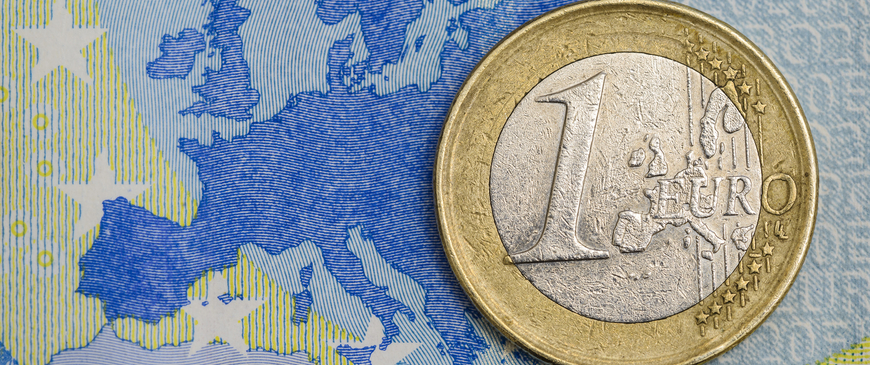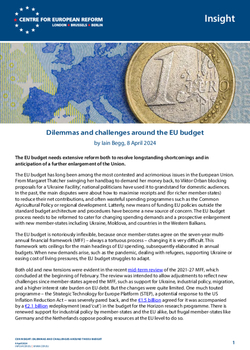
Dilemmas and challenges around the EU budget
The EU budget needs extensive reform both to resolve longstanding shortcomings and in anticipation of a further enlargement of the Union.
The EU budget has long been among the most contested and acrimonious issues in the European Union. From Margaret Thatcher swinging her handbag to demand her money back, to Viktor Orban blocking proposals for a ‘Ukraine Facility’, national politicians have used it to grandstand for domestic audiences. In the past, the main disputes were about how to maximise receipts and (for richer member-states) to reduce their net contributions, and often wasteful spending programmes such as the Common Agricultural Policy or regional development. Latterly, new means of funding EU policies outside the standard budget architecture and procedures have become a new source of concern. The EU budget process needs to be reformed to cater for changing spending demands and a prospective enlargement with new member-states including Ukraine, Moldova, and countries in the Western Balkans.
From Margaret Thatcher swinging her handbag to demand her money back, to Viktor Orban blocking proposals for a ‘Ukraine Facility’, the EU budget has long been amongst the most acrimonious issues in the EU.
The EU budget is notoriously inflexible, because once member-states agree on the seven-year multi-annual financial framework (MFF) – always a tortuous process – changing it is very difficult. This framework sets ceilings for the main headings of EU spending, subsequently elaborated in annual budgets. When new demands arise, such as the pandemic, dealing with refugees, supporting Ukraine or easing cost of living pressures, the EU budget struggles to adapt.
Both old and new tensions were evident in the recent mid-term review of the 2021-27 MFF, which concluded at the beginning of February. The review was intended to allow adjustments to reflect new challenges since member-states agreed the MFF, such as support for Ukraine, industrial policy, migration, and a higher interest rate burden on EU debt. But the changes were quite limited. One much touted programme – the Strategic Technology for Europe Platform (STEP), a potential response to the US Inflation Reduction Act – was severely pared back, and the €1.5 billion agreed for it was accompanied by a €2.1 billion redeployment (read ‘cut’) in the budget for the Horizon research programme. There is renewed support for industrial policy by member-states and the EU alike, but frugal member-states like Germany and the Netherlands oppose pooling resources at the EU level to do so.
The review’s main positive outcome was agreement on the Ukraine Facility, worth up to €50 billion over the period to the end of 2027, after Orban was persuaded to drop his veto. It is composed of €33 billion for loans to support the country’s public finances and €17 billion in grants. It is not entirely ‘new’ money because support had already been programmed for Ukraine under existing EU programmes, but it is a vast amount that has been welcomed in Kyiv.
In her 2023 State of the Union address, Commission president Ursula von der Leyen identified reforming the EU’s finances as a pre-condition for a further enlargement of the EU. Such reform should happen irrespective of enlargement and is long overdue, having last been undertaken in 1988. There are three main challenges which reforms must address: reconciliation of the regular budget with off-budget borrowing, the need for increased resources, and securing political legitimation for the EU budget process.
The EU budget faces three major challenges: reconciliation of the regular budget with off-budget borrowing, the need for increased resources, and securing political legitimation for the budget process.
Of these, the biggest is how to reconcile the traditional MFF-based EU budget with the EU’s increasing resort to off-budget borrowing to fund EU policies. The prime example of the latter is the massive, if temporary, pandemic recovery fund – Next Generation EU (NGEU) – approved in 2020. The programme is funded by the EU borrowing €800 billion from capital markets. The EU’s reliance on debt has awkward ramifications for the coming years because the EU must pay interest on the loans. The bonds can perhaps be partly ‘rolled over’ – paying off debt by issuing new debt – but some of it (eventually) must be repaid, not least to establish the Commission as a credible borrower in financial markets. This will have to come from future annual budgets.
Some of the NGEU money is disbursed to member-states as ‘back-to-back’ loans: the Commission borrows, lends-on at the relatively favourable interest rate it enjoys, then member-states must both service and repay the loans. Unless a recipient defaults (unlikely), there should be no call on the EU budget.
However, the bigger component of NGEU is for grants, going disproportionately to member-states in southern, central and eastern Europe. This component imposes future burdens on the EU budget. When NGEU was adopted, interest rates were at historic lows and repayment seemed distant. There was some provision for the interest payments in the 2021 Own Resources Decision, but it soon became apparent that it would not be sufficient. The new Ukraine Facility will also be funded outside the MFF, with the EU again borrowing the money directly from financial markets.
Loan repayments are a first call on the EU’s finances, taking precedence over other outlays. Because interest rates have surged to combat inflation, the need to find money to service the EU’s loans risks crowding-out other expenditure, upsetting the delicate political compromises required to arrive at EU budget deals. Attempts to find solutions have proved difficult, and the mid-term review essentially ‘kicked-the-can-down-the-road’ by setting out a sequence of steps through which more money would be raised. First, the agreement refers to using savings from existing EU spending. If that is not enough, member-states would be asked to pay more, though this would be through an ‘exceptional and limited’ instrument outside the MFF framework.
Most finance ministers would balk at increasing payments to the EU. This points to a second major challenge, namely whether to allow the EU to raise its revenue in a different way. Since the late 1980s, the bulk of EU revenue has come from contributions from member-states, mainly linked to their gross national income (GNI).
Most finance ministers would balk at increasing payments to the EU. This points to a major challenge, namely whether to allow the EU to raise its revenue in a different way.
The Commission has been trying over many years to secure separate dedicated sources of revenue for the Union, so-called ‘own resources’. Only around 15 per cent of EU revenue in recent years has come from genuine own resources, principally the proceeds of tariffs levied on imports from the rest of the world. Numerous studies and EU documents (for example, a high-level group chaired by Mario Monti, a recent study for the European Parliament and a communication from the European Commission) have proposed potential new own resources – from a financial transaction tax, to a share of corporate profits taxes, to a small charge on SMS text messages, to a carbon border adjustment mechanism (a levy on the carbon content of imported goods).
Member-states have long been loath to confer a ‘power to tax’ on the EU. In addition to political resistance, the search for own resources has been largely in vain because possible resources have an uneven incidence on different countries and regions, there might be collection problems, or their yield might be very volatile. The only new resource to have been introduced since 1988 is a small levy on use of non-recyclable plastics from 2021, and, even then, the proceeds are tied to the GNI of the country, rather than directly to use of plastics. Reducing the direct burden on national contributions will not reduce the burden on taxpayers, as own resources will require creating new taxes or raising more from existing ones. Those who believe new own resources mean additional revenue may be deluding themselves because taxpayers may object instead of finance ministers.
Democratic legitimation of the budget is the third challenge. The European Parliament and the Council of Ministers constitute the ‘budgetary authority’ charged with deciding on the EU’s expenditure. In practice, the Council agrees first, but the Parliament then has to approve the MFF, and the two institutions are then jointly responsible for the annual budgets. However, the Parliament is in the unusual position of having next to no say on revenue-raising and has little influence on decisions about off-budget mechanisms. The resulting dilemma for the Parliament is that it will have future responsibility for approving annual budgets which include payments of interest and amortisation of loans, yet little meaningful say in deciding on new off-budget mechanisms such as the Ukraine Facility which create those loans in the first place.
Although the EU spends a large amount of money every year (€186 billion in 2023), this is barely 1 per cent of EU GDP and a little over 2 per cent of aggregate public spending by all levels of government. The federal budget in the US, by comparison, has averaged around 23 per cent of GDP in recent years ($6.1 trillion in 2023). Significant change is unlikely in the short run, as a revealing figure in the Presidency Conclusions of February 2024 shows: ‘total fresh money’ will amount to only €21 billion over the remainder of the MFF, an increase of barely 2 percent per year, nearly all of which is the new grants for Ukraine. Most of the budget revision is arrived at through a mix of reductions in the funding envelopes for existing programmes and expected future member-states contributions.
Ursula von der Leyen identified three imperatives for reform: “we need to discuss the future of our budget – in terms of what it finances, how it finances it, and how it is financed”. What she does not tell us is how this will happen, nor did the mid-term review offer a clear direction of travel. The next set-piece will be the negotiation of the next MFF which, if it follows past patterns, will descend into haggling about fractions of a percentage point of GDP and net positions.
If enlargement happens as soon as 2030, as Charles Michel has (rather implausibly) suggested, it will occur halfway through the next seven-year MFF cycle. Even if there are transitional measures to mitigate the budgetary consequences (a phasing-in of direct payments to farmers in the new member-states, for instance), the strains would be significant. For this reason, the MFF negotiations would be an inadequate way forward, recalling that while the negotiation of the 2000-2006 MFF (labelled Agenda 2000) sought to anticipate enlargement, it did not fundamentally reshape the EU budget.
Some might argue that a high-level group should be established. But this has been tried before: the group led by Mario Monti in the mid-2010s did not result in much change. A better option could be to convene a limited inter-governmental conference with the sole objective of arriving at a new budgetary settlement for the EU. It should focus on the overall fiscal framework, bringing together the income and expenditure sides of the budget, while also finding enduring solutions to the use of borrowing to fund EU policies. A successful reform effort will not only make better use of EU funds and prepare the Union for enlargement but can also put EU finances on a more legitimate footing.
Iain Begg is a professorial research fellow at the European Institute, London School of Economics and Political Science.


Add new comment